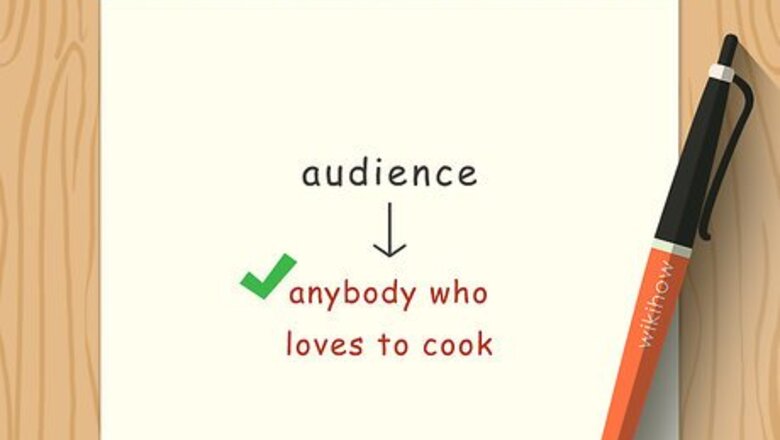
views
Getting Ready to Write

Assess your audience’s skill level. Before you put pen to paper, take a few moments to consider who will be reading your essay. This will narrow down the type of language that you’ll use and the information that you’ll include. If you are writing for an expert audience, then you can remove some of the basic information that you’d include for beginners. For example, a process essay intended for professional chefs could probably skip a description of how to chop carrots and just say, “Finely chop the carrots,” instead.
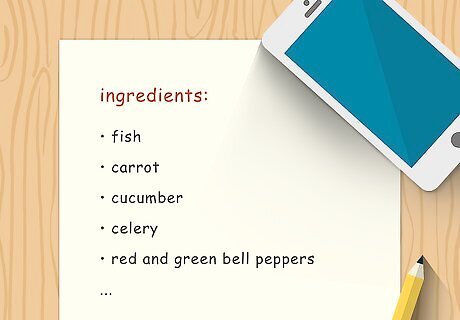
Make a list of the materials needed. Go through the process from start to finish and write down every single item that someone would need to complete the task. Include everything from the common to the unusual. Then, keep the list by you as you write and check off each item as you mention it. You could also include a comprehensive “Things You’ll Need” section at the beginning of the paper. Or list the materials needed after the introduction. If an item on the list is a bit unusual, such as a particular type of hand tool, then make sure to clearly introduce it within the text. For example, “The pin hammer has a finer tip than a standard hammer, making it suitable for more detailed work.” You can also include a picture of the item, particularly if the essay will be published online.
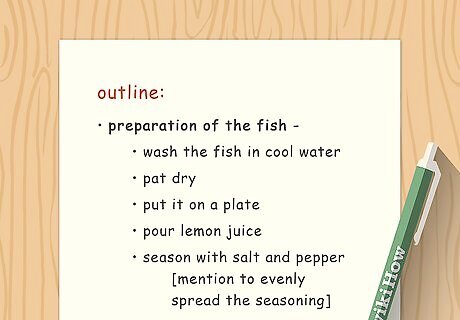
Create an outline of the task. In either a series of short sentences or bullet points, list out each step of the task from start to finish. You can divide your outline into 3 parts that mirror the structure of an essay: introduction, body, and conclusion. After you complete your outline, read it over to make sure that you haven’t left any steps out. You can also go back through and add any details that you don’t want to leave out. If you are writing an essay about how to cook lasagna, your initial outline might just state, “Mix in basil.” Before you start writing, you could expand your outline to say, “Briefly mention taste differences between dried and fresh basil.” Note that the more specific your article or essay topic, the more specific your details needs to be.
Crafting an Introduction

Grab your reader’s attention within the first 1-2 sentences. Start off with a quick, colorful description of the task at hand. Or, begin with a brief anecdote explaining why the task at hand is so important. Keep your language vibrant and lively. Remember that this is the moment when your reader will decide whether or not they’ll continue to read. For instance, you might write, “The process of preparing lasagna has a rich heritage all of its own.”
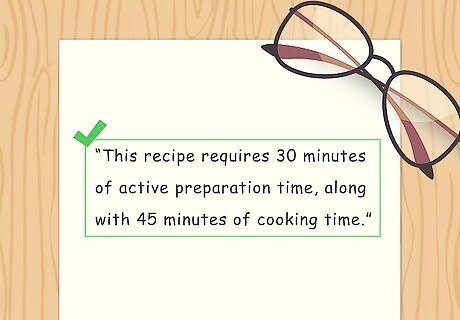
Provide a general time estimate. Most readers won’t have all the time in the world to complete this task, so they’ll want to know right away how long it will take. Be honest and give your reader a true estimate from start to finish. If the task requires multiple materials, you might also let your reader know that they can reduce the timeframe by gathering everything in advance. If your process essay focuses on a cooking task, this is where you might advise your readers to consult the ingredients or materials list and put every item on the counter. For example, you might write, “This recipe requires 30 minutes of active preparation time, along with 45 minutes of baking time.”
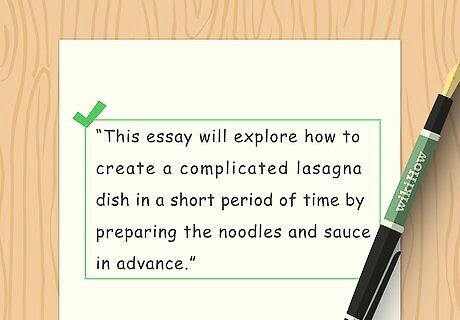
Present the thesis statement as a problem. The thesis statement should be the last sentence of your introductory paragraph. It is the most important sentence of your paper and tells the reader not only which problem you’ll examine, but it should give them an idea as to how you’ll solve it. This gives your paper a sense of forward motion. For example, your thesis might be, “This essay will explore how to create a complicated lasagna dish in a short period of time by preparing the noodles and sauce in advance.”
Writing Your Body Paragraphs
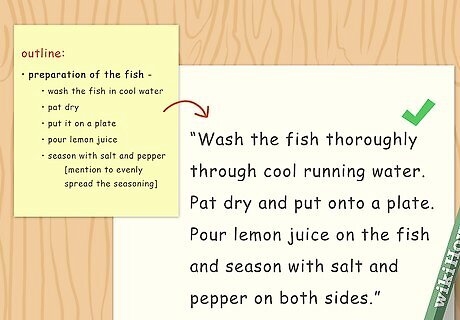
Consult your outline. Keep your outline next to you as you write and check off each sentence or bullet point as it’s covered. The body of your essay will closely follow your outline and head in order from the first step to the last. Make sure to keep your steps clear and in the right order. Be especially careful with items that contain multiple steps. Make the transitions clear and acknowledge prior steps regarding a particular item, if applicable.
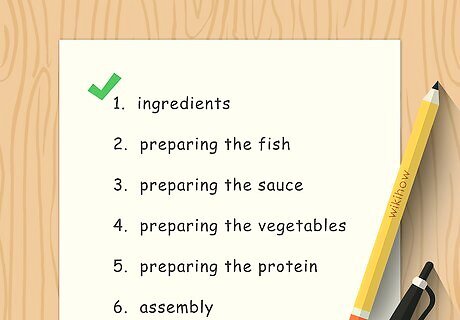
Structure the body of the essay in paragraphs. A standard process essay might have 3 or more body paragraphs. Don’t try to overload each paragraph with too many details or you might confuse or lose your reader. For instance, when making pasta, consider writing a paragraph on how to boil pasta and another paragraph on how to make the sauce. This separates the ideas for easy clarification.

Add transitions in between steps. Use transition or signal words to encourage your reader to continue on from one step to another. As you go along, you can transition from one thing to the next with words like “next,” “now,” or “then.” This will make your essay sound more cohesive and less like a list of boxes to check. For instance, you could write, “Next, place the pot on the stove,” to move from one paragraph to the next.
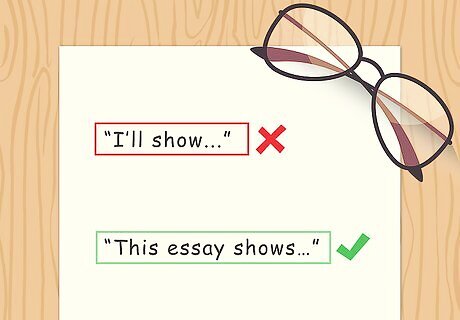
Avoid using first person pronouns. Including “I, we, us, me, mine, our, and ours” within your writing can make it seem less declarative and authoritative. In a process essay, this can make a reader less likely to trust your instructions. Instead, stick with a second and third person perspective by using words, such as “it or they.” For example, you could write, “This essay shows…” instead of “I’ll show.”
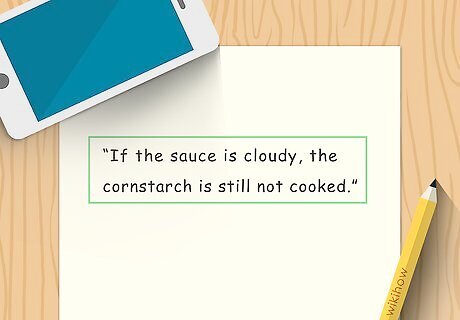
Mention any cautionary notes. If there are particular things that your reader should avoid doing, make sure to describe these either in the main body paragraphs or in the conclusion. This is especially important to do if the task is potentially dangerous or harmful. For example, you might caution a reader to, “Cook the meat until it is no longer red in the center.” This advice will help them to avoid a foodborne illness.
Wrapping It Up
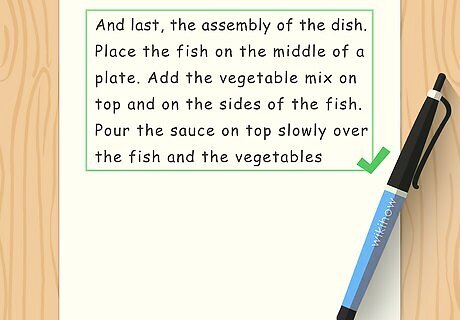
Mention the end product and what to do with it. The last few paragraphs of your paper should wrap up the production process. They should also give your reader an idea of what to expect from the final product. You might describe what it looks like or what a reader could use it for. Don’t assume that your reader will automatically know what to do when they are finished with the creation process. In the case of the recipe, you could write something like, “You now have a bowl of boiled pasta and finished Bolognese sauce. Serve up plates of pasta and sauce to your family, topping them with parmesan, if desired. You can serve garlic bread or a side salad with this dish, too.”

Restate the importance of the task. This is a great, positive way to end your essay. Remind your reader once again why they put so much effort into following your directions and completing the task. Avoid repeating your introduction back word for word. Instead, focus on providing a bit of praise for a reader who has stuck it out. A simple example for our newly-made dinner might be, "And there you have it! A delicious yet quick meal fit for the entire family that you can make over and over again without complaint. Next time, experiment with different herbs and spices to find your own spin on this classic dish."
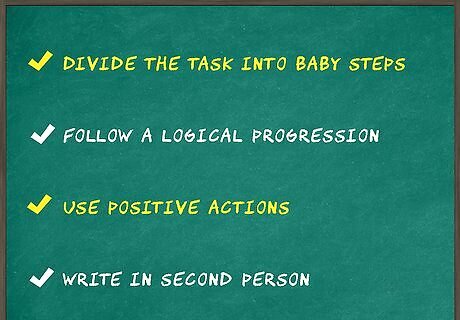
Check your essay for ease of reading. When you’ve finished writing your process essay, sit down and reader through it slowly. Picture each step in your mind and check to see if your descriptions match each visual. Verify that your paragraphs are in the right order, too. Look to see if there are places where you can eliminate steps or condense your instructions. A reader is more likely to finish directions that they can easily skim through. Ask someone to read through the essay to see if they can understand the process. If possible, pick someone from your intended audience demographic.

Proofread your essay. Read through your essay looking for grammatical mistakes, typos, and other errors. These types of writing problems can distract or even confuse a reader. It sometimes helps to step away from your essay for a few hours before completing this final step. Don’t rely on spell-check alone, as it cannot account for context and doesn’t catch every error.













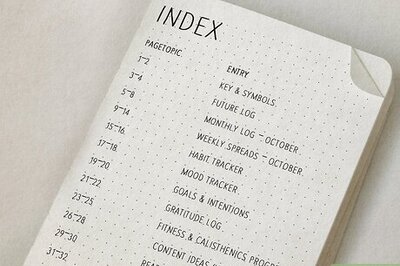

Comments
0 comment